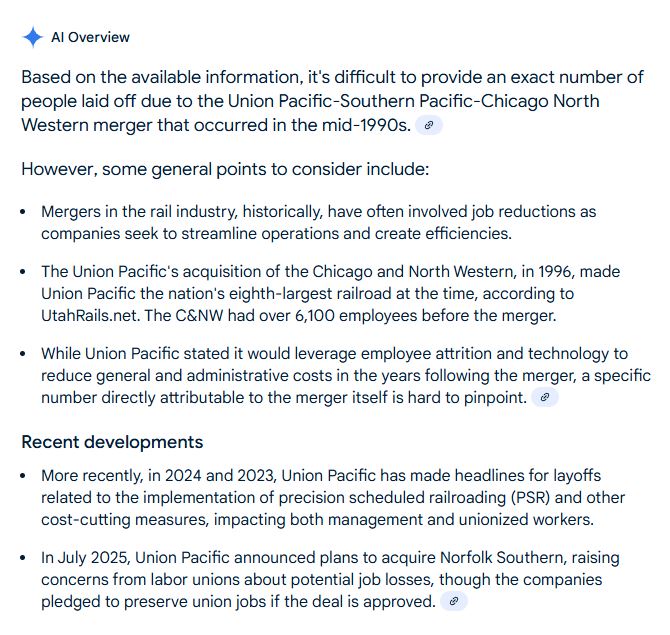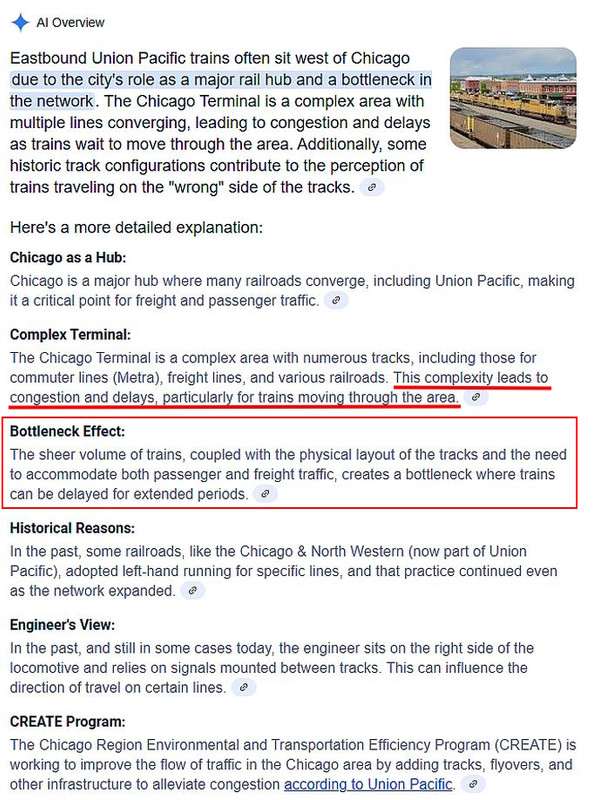I don't think NAFTA is entirely to blame for that. I am on the other side of the continent and the north side of the "line". We lost over half the lumber mills since 2009 (where I have data for), and many more earlier. And we also lost the rail lines where lumber was the main business.Lumber was curtailed thanks to NAFTA
Install the app
How to install the app on iOS
Follow along with the video below to see how to install our site as a web app on your home screen.
Note: This feature may not be available in some browsers.
You are using an out of date browser. It may not display this or other websites correctly.
You should upgrade or use an alternative browser.
You should upgrade or use an alternative browser.
UP-NS Agree to $85 Billion Merger
- Thread starter AdvancedApproach
- Start date
In Maine, a big portion of the lumber business went north. Today, lumber comes down out of New Brunswick via the New Brunswick Southern for consumption in the US.I don't think NAFTA is entirely to blame for that. I am on the other side of the continent and the north side of the "line". We lost over half the lumber mills since 2009 (where I have data for), and many more earlier. And we also lost the rail lines where lumber was the main business.
butch_koch
Member
Remember when monopolies use to be illegal?
AdvancedApproach
Well-known member
NAFTA is solely to blame for that. People wanted cheaper products, but it came at a great expense to the economy and workers.I don't think NAFTA is entirely to blame for that. I am on the other side of the continent and the north side of the "line". We lost over half the lumber mills since 2009 (where I have data for), and many more earlier. And we also lost the rail lines where lumber was the main business.
Where I live, we lost lumber mills because of protests over logging. Environmental groups protested every single proposed timber sale on US Forest Service no matter how badly it was needed for the health of the forest or how well set up and managed it was for selective cutting, even helicopter logging. It got so none of the mills could buy federal timber sales and they went under.
AdvancedApproach
Well-known member
That’s on them for not having some backbone and telling the protestors to kick rocks.Where I live, we lost lumber mills because of protests over logging. Environmental groups protested every single proposed timber sale on US Forest Service no matter how badly it was needed for the health of the forest or how well set up and managed it was for selective cutting, even helicopter logging. It got so none of the mills could buy federal timber sales and they went under.
AdvancedApproach
Well-known member
So the federal laws were created due to NIMBYS protesting?They couldn't. Federal laws would not let them. Every protest had to be processed through, and it basically shut the system down. Believe me, we had some enviros who knew how to work the system.
AdvancedApproach
Well-known member
The heck with those laws and all those people who wrote them. I'd just blatantly disobey it and thumb my nose at them just to see what they do.No, the federal laws were written by environmentally conscious people, but the way they were written allowed extremists to carry it to extremes and lock everything up. The Forest Service was left no leeway to do what was reasonable and proper.
In some ways I can see why the protesters did what they did, yet at the same time, they didn't understand the industry as it is today.Where I live, we lost lumber mills because of protests over logging. Environmental groups protested every single proposed timber sale on US Forest Service no matter how badly it was needed for the health of the forest or how well set up and managed it was for selective cutting, even helicopter logging. It got so none of the mills could buy federal timber sales and they went under.
The lumber industry in New Hampshire died in the 1940s because of excessive cutting. What was once vast forests became desolate and barren hills and mountainsides with washouts and forest fires. These areas today are what constitute the White Mountain National Forest.
Today, there is a small lumber industry left that ships mostly by truck, although recently the Vermont Railway System has purchased the New Hampshire Central and the former Maine Central Mountain Division along with the former Boston and Maine mainline to Berlin, New Hampshire. They have recently started clearing brush and trees on the long dormant Mountain Division between Gilman, Vermont and Whitefield, New Hampshire with plans to handle outgoing lumber and wood products as well as other freight such as plastic pellets, ethanol, petroleum products, and general freight. They eventually hope to open the line up completely to St. Johnsbury in the future.
To the south, the owner of the Conway Scenic is looking to purchase the southern portion of the Mountain Division from Portland, Maine to Intervale. They already run some infrequent freight on the CSRR and this will extend the service. The Maine legislators are "taking this under review" with a lobbyist fighting for the rail-to-trail industry against rail restoration. They too plan to handle wood products from the region.
Overall, NAFTA did kill the industry up here by sending it over the border to Canada. It didn't help that the 1989-1992 recession put nails in the coffin for the paper industry. Today, there are only 3 paper mills left in Maine. Today, lumber is still cut up in Maine but most of it comes in from New Brunswick Canada via the NBSR. Interchange is done with the Maine Eastern.
UP-NS Merger News.

 www.waterwaysjournal.net
www.waterwaysjournal.net



Proposed Rail Merger Draws Pushback - The Waterways Journal
A coalition of powerful interests is lining up to oppose a proposed merger between two of the nation’s largest Class 1 railroads, Union Pacific (UP) and Norfolk Southern (NS). Opponents are concerned that Class 1 freight rail competitors CSX and BNSF might respond by merging, creating a...


Last edited:
Bill Stevens did a write up on the proposed UP-NS merger. Here are the issues I noted:
The railroads claim that the merger will
"transform the U.S. supply chain and economy, strengthen domestic manufacturing, and preserve all union jobs"
UP and NS apparently are each other's largest interchange partners, exchanging about 1 million shipments per year. So if they can reduce delays in that area, it may improve service for some customers. NS CEO Mark George claims that they will be more competitive with trucking if they reduce such delays. No comment how that will help competing with trucks in the areas of their systems that won't experience changes from the merger.
The railroads also expect that by the third year they will have $1.75 billion in growth related revenue and an additional $1 billion in cost and productivity savings.
So how many facilities will be closed and jobs lost as a part of that $1 billion savings? Good for investors, but perhaps not for local economies.
The railroads claim that the merger will
"transform the U.S. supply chain and economy, strengthen domestic manufacturing, and preserve all union jobs"
UP and NS apparently are each other's largest interchange partners, exchanging about 1 million shipments per year. So if they can reduce delays in that area, it may improve service for some customers. NS CEO Mark George claims that they will be more competitive with trucking if they reduce such delays. No comment how that will help competing with trucks in the areas of their systems that won't experience changes from the merger.
The railroads also expect that by the third year they will have $1.75 billion in growth related revenue and an additional $1 billion in cost and productivity savings.
So how many facilities will be closed and jobs lost as a part of that $1 billion savings? Good for investors, but perhaps not for local economies.
AdvancedApproach
Well-known member
There's a number of problems with that. I already got a job offer only for them to revoke it after finding out my rap sheet is longer than an ocean liner. Another thing is they don't want rank and file or career railroaders in any position of management or authority. They want a bunch of college grads with this "yes man" mentality because having some college degree of logistics, business administration or anything relatively close. Sad part is a lot of these idiots who wield way too much power don't even know the difference between an absolute and a permissive signal. Then let's say I get past all of that, you have to deal with the shareholders. Once you become senior level management or executive, the shareholders control every bit of your railroad decision making. You're the slave and they're your masters. It's like a plantation mentality. I'm not down for that crap. They tell you to jump, you say "how high sir?" They tell you increase profit margins even at the expense of growth or long-term sustainability there's only one appropriate response "yes sir masa." That's the long-winded version of why me working up the ladder won't work.Well, you can get hired on, work your way up.
This doesn't happen only in railroad operations. Companies are no longer run by people that work their way up from the bottom. Today, it's all about maximizing profit over quality of product and service and maximizing bonuses for the CEO and other C-level management, and ever-increasing stock dividends for the stockholders and investment firms, which drive a huge part of this fall to the bottom. To accomplish this, companies bring in MBAs who live by spreadsheets and have absolutely no clue about the company and its products or services.There's a number of problems with that. I already got a job offer only for them to revoke it after finding out my rap sheet is longer than an ocean liner. Another thing is they don't want rank and file or career railroaders in any position of management or authority. They want a bunch of college grads with this "yes man" mentality because having some college degree of logistics, business administration or anything relatively close. Sad part is a lot of these idiots who wield way too much power don't even know the difference between an absolute and a permissive signal. Then let's say I get past all of that, you have to deal with the shareholders. Once you become senior level management or executive, the shareholders control every bit of your railroad decision making. You're the slave and they're your masters. It's like a plantation mentality. I'm not down for that crap. They tell you to jump, you say "how high sir?" They tell you increase profit margins even at the expense of growth or long-term sustainability there's only one appropriate response "yes sir masa." That's the long-winded version of why me working up the ladder won't work.
To an MBA, employees technically shouldn't be working at all because they cost the company money. IT in particular, is offshored and outsourced so not to cost the company money at all except for the services that they pay the least for. Product development may be done in-house, but all manufacturing and production is done offshore where the company can pay the least. Programming is done through contractors, usually found now in India where they can pay even less, so that very few employees need to be paid. This is why we see a lot of serious bugs and cyberattacks. There's no one held accountable. Once an employee is finished, they are let go until a new project comes along. A programmer may be lucky if they get the same project and company again another time.
I saw this at Oracle. The owner bought a new yacht and land on an island off of Hawaii while telling the sales people that they couldn't receive their commissions.
AdvancedApproach
Well-known member
That's why we need to pass laws banning offshoring or outsourcing to other countries. Either that or impose a steep tax on the company and their shareholders. Better yet even ban the company and its products from America unless they bring all manufacturing and final production here and stop outsourcing to third world countries. That might jack up the supply chain but will reign these greedy pigs in.This doesn't happen only in railroad operations. Companies are no longer run by people that work their way up from the bottom. Today, it's all about maximizing profit over quality of product and service and maximizing bonuses for the CEO and other C-level management, and ever-increasing stock dividends for the stockholders and investment firms, which drive a huge part of this fall to the bottom. To accomplish this, companies bring in MBAs who live by spreadsheets and have absolutely no clue about the company and its products or services.
To an MBA, employees technically shouldn't be working at all because they cost the company money. IT in particular, is offshored and outsourced so not to cost the company money at all except for the services that they pay the least for. Product development may be done in-house, but all manufacturing and production is done offshore where the company can pay the least. Programming is done through contractors, usually found now in India where they can pay even less, so that very few employees need to be paid. This is why we see a lot of serious bugs and cyberattacks. There's no one held accountable. Once an employee is finished, they are let go until a new project comes along. A programmer may be lucky if they get the same project and company again another time.
I saw this at Oracle. The owner bought a new yacht and land on an island off of Hawaii while telling the sales people that they couldn't receive their commissions.
marmalade32
Active member
I think we should bring back the espee. GIVE US THE RED AND GREY GOATS BACK!!!
AdvancedApproach
Well-known member
That's not gonna happen. They had an opportunity to be around, and the idiot Benjamin Biaggini screwed them over. Phillip Anscutz might've saved them from liquidation but didn't keep his promise of not selling out. He could've brought them back to health but just wanted to increase the value just for a purpose of getting his money back and then some.I think we should bring back the espee. GIVE US THE RED AND GREY GOATS BACK!!!
Similar threads
- Replies
- 2
- Views
- 419
- Replies
- 1
- Views
- 401
- Replies
- 4
- Views
- 475
- Replies
- 0
- Views
- 653
- Replies
- 0
- Views
- 687

